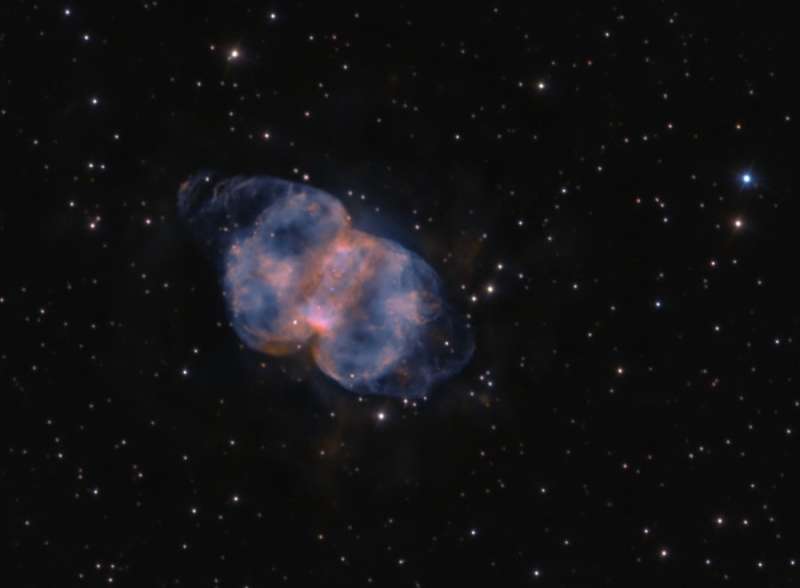
|
Credit & Copyright: Ken Crawford
(Rancho Del Sol Obs.)
Explanation:
"Nebula at the right foot
of
Andromeda ... " begins the description
for the 76th object in Charles Messier's 18th century Catalog
of
Nebulae and Star Clusters.
In fact, M76 is
one of the fainter objects on the Messier list and
is also known by the popular name of the "Little Dumbbell Nebula".
Like its brighter namesake M27
(the Dumbbell Nebula), M76 is recognized
as a planetary
nebula - a gaseous shroud cast off by a
dying sunlike star.
The nebula itself is thought to be shaped more like a donut, while the
box-like appearance of its brighter central
region is due to our nearly edge-on view.
Gas expanding more rapidly away from the donut hole produces the
fainter loops of far flung material.
The fainter material is emphasized in this composite image, highlighted
by showing emission from hydrogen atoms in orange and oxygen atoms
in complementary blue hues.
The nebula's dying star can be picked out in
the
sharp false-color image as blue-tinted star near the
center of the box-like shape.
Distance estimates place M76 about 3 to 5 thousand light-years away,
making the nebula over a
light-year in diameter.
|
January February March April May June July August September October November December |
| ||||||||||||||||||||||||||||||||||||||||||||||||
NASA Web Site Statements, Warnings, and Disclaimers
NASA Official: Jay Norris. Specific rights apply.
A service of: LHEA at NASA / GSFC
& Michigan Tech. U.
Based on Astronomy Picture
Of the Day
Publications with keywords: planetary nebula
Publications with words: planetary nebula
See also:
- APOD: 2025 August 31 Á NGC 7027: The Pillow Planetary Nebula
- APOD: 2025 August 22 Á A Tale of Two Nebulae
- APOD: 2025 August 5 Á NGC 6072: A Complex Planetary Nebula from Webb
- APOD: 2025 July 29 Á A Helix Nebula Deep Field
- APOD: 2025 July 13 Á Planetary Nebula Mz3: The Ant Nebula
- APOD: 2025 June 9 Á Between Scylla and Charybdis: A Double Cosmic Discovery
- APOD: 2025 May 14 Á NGC 1360: The Robins Egg Nebula
